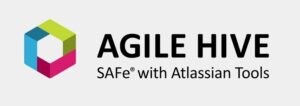Agile Hive: SAFe® with Atlassian Tools

What is SAFe®?
SAFe® is designed to tame the scope of agile processes beyond the actual development teams. You could say it can make product development across the entire company agile. A Scaled Agile Framework provides a structure that is not limited to the team level but also integrates those of the programs, more extensive solutions, and portfolios right up to practices integrated into the fabric of the entire organization.
The framework outlines various techniques, roles, meetings, and artifacts, partly borrowed from the lean approach, that serve the overall goal of delivering products via so-called Agile Release Trains (ARTs). These ARTs, drive “through entire value streams and offer integration and coordination possibilities at each stop. Anyone looking at SAFe® processes for the first time might feel overwhelmed by the abundance of terms and components. In practice, all these elements should fit together and function in an interlocking way to ensure an optimal flow. For a better understanding, it can help to look at the framework in its individual components.
SAFe® can be implemented in four different configurations depending on individual requirements, size of the organization, scope, and several products. These configurations are Essential SAFe® (the heart and core of SAFe®), Portfolio SAFe®, Large Solution SAFe®, Full SAFe®. SAFe® comprises four levels with different tasks and functions - from the team up to the portfolio.
Team level
Agile teams usually consist of a development team, product owners, and a scrum master. They organize themselves (as they usually would) using Scrum, possibly Kanban or other agile working methods. They would also implement user stories in their sprints or iterations as usual. The teamwork focused POs are each responsible for one or two sub-products and, in this context, also support product management at the program level. Program level: The Scaled Agile Framework groups five to ten development teams into so-called Agile Release Trains (ARTs). These teams work together on features, which are the value-adding elements at the program level. Depending on the size of the company, there are possibly several value streams in the organization that are served by corresponding ARTs.
Following a steady tempo of iteration releases, the Program Increment (PI), the increments of the individual teams are merged, tested, and potentially deliverable via the ART. If this also results in a clear release cycle, SAFe® propagates and supports the DevOps approach concerning Continuous Delivery or Release on Demand. It is the responsibility of the people within various roles at the program level to plan the individual components of a PI and to provide organizational support for their implementation.
Portfolio level
At the portfolio level, value stream mapping is used to define the value streams. This forms the basis for target-oriented release trains that operate as independently as possible. In large organizations, there are sometimes several portfolios. In this case, it is particularly important to ensure that the programs are aligned with corporate strategy and investment decisions (themes) in terms of budgets and overall goals (Epics).
Portfolio elements are also developed as lean-agile as possible and are managed on a Kanban basis to ensure that resources are value-focused. Once approved, they are transferred to the lower levels, where they are broken down into the relevant implementation units. The portfolio level also has the task of controlling continuous improvement and optimization processes. In this case, various metrics are available as a basis for recording and assessing the flow.
Large-solution level: The large-solution level between the program and portfolio level is only relevant in organizations that develop (or are involved in developing) extensive solutions. This means if value flows are so comprehensive that they cannot be realized by a single ART, several ARTs are combined into solution trains analogously to the system, as mentioned earlier. Any external suppliers that may be necessary can also be taken into account at this level. Solution intent, solution management, architecture, agile relationship management with partners and customers, and the coordination of the value stream are central tasks on this scale.
Would you like to learn more about SAFe or Agile Hive? Contact Us!
Further Reading
Jans Einfach: Agile and Atlassian explained | A short introduction to “Agile Hive – SAFe with Atlassian Tools.”
SAFe with Atlassian tools: Agile Hive is a Scaled Agile Platform Partner
Remote PI planning with Agile Hive
Learn more about Creative Commons licensing and //Seibert/Media



